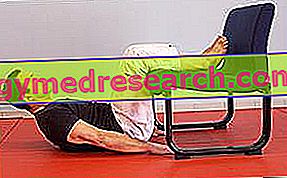To be able to design a correct and functional abdominal training a small introduction on their anatomy and physiology is required.
The abdominal or rather the rectum of the abdomen is a single muscle (there are no high and low abdominals), it originates from the sternum and is inserted on the pubis.
When correctly developed this highlights 6 epigastri (the classic tiles).
Its function allows, in a classic crunch on the ground, to raise the trunk by about 30 °. Easy to identify angle, during training, because it represents the point where the scapular tips begin to come off the ground. From this angle on, any other movement is caused by the thigh flexor muscles among which the most important is the Ileo-Psoas. This originates from the lumbar vertebrae and is inserted on the small trochanter at the femoral level. Excessive training, without a proper muscle stretching program, can create annoying lumbago.
Let's go back to the anatomy of the rectum of the abdomen. If it is true that the rectum has a movement of about 30 ° it is equally true that it reaches its maximum muscular tension by extending the trunk, before flexing it, by about 15 °. It becomes so easy to understand how a crunch performed on the ground does not allow a workout on the whole joint range of the muscle.
Another necessary clarification. In the classic crunch, the hands are placed behind the neck to lighten the muscular tensions that weigh on it during the exercise.
Physiology expert Mel Siff, however, states that supporting the head with the hands behind the neck engages a reflex contraction of the shoulder stabilizing muscles. Much better, therefore, to leave your arms along your body by simply letting them slide next to your legs during the exercise. If the problems persist an excellent help could be given by a towel that protrudes a few centimeters beyond the shoulders. Grabbing it with your hands, you will create an excellent tool, similar to those on the market to lighten cervical tensions during exercise.

Figure 1. Exercise for strengthening the static or dynamic abdominals.
Series and repetitions
Observing that it is common practice to train the abdominal cavity with a high number of repetitions it is useful to understand the differences between tonic and phasic musculature.
The former are muscles suited to resistance. An example on all the soleus, a small muscle of the calf that, guaranteeing us a lasting propulsion in the course of the walk, needs a physiological composition that leads it to last over time with a prevalence of slow-twitch fibers. The postural muscles present these characteristics.
The latter instead consist of fast-twitch fibers. This type of fiber responds optimally to training with high weights and, consequently, with low numbers of repetitions.
The abdominals, strange but true, consist mainly of this type of fiber. Consequently, training them with repetitions of more than 15 results practically ineffective for achieving our goal, therefore:
- for beginners it is recommended to use resistors that allow about 15 rips. for 2/3 series .
- for the more experienced it is possible to work on the 8/12 rip. for at least 3 series .
- for athletes you can use important loads that allow only 4 repetitions per series .
Exercises
Great exercise is to do sit- ups on a Swiss ball or Bobat or Fitball ball . The exercise performed on a ball allows a training that allows an optimal muscular activation on the whole articular range of the fiber itself. Its second characteristic is to make the exercise unstable. This allows for the involvement of deep muscle fibers and an improvement in balance.
When the exercise will be carried out easily it is possible to use loads with dumbbells on the chest. Discs can also be used but their size generally prevents complete closure during movement.
A second exercise that can be done using the Fitball is reverse crunch. Performed in the same way as a reverse crunch on the ground, except that on the ball there is an extension of the trunk and, therefore, a more intense work on the affected muscle. For the stability of this exercise it is necessary to anchor with the arms to a firm structure.
In light of the above, it is necessary to make a small clarification on the execution of the classic leg raise (raise the legs in suspension). It is effective if before the exercise you make an anteroversion of the pelvis (slight arching of the back) and in the closing phase it ends by removing the buttocks from the backrest. Carrying out, therefore, a crunch with the adversity of the force of gravity.
Still, exercises are done and repeated on the obliques with torsions of the torso using overloads that certainly do not represent an optimal training.
The movement in torsion (and maybe even in bending of the torso) is a harmful movement for our spine.
And if the intention is to reduce the handles of love the goal will never be reached, on the contrary ... but this is another story that I will tell you next time!



